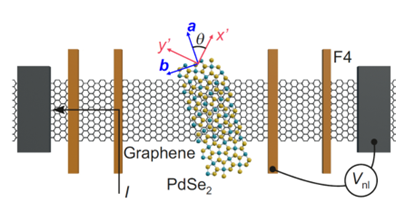ICN2 researchers have demonstrated how the interaction with palladium diselenide (PdSe₂) can modify and enhance graphene’s spintronic performance. These findings, published in Nature Materials, improve our understanding of spin dynamics in graphene-based van der Waals heterostructures and could be key for developing more efficient computing devices.

Van der Waals heterostructures are materials formed by combining layers of different ultra-thin materials stacked on top of each other. In recent years, these structures have proven to be very useful for studying and understanding unusual physical phenomena, making them promising candidates for the development of new technologies. A recent study led by Dr Juan Sierra and Josef Světlík, under the supervision of ICREA Prof. Sergio Valenzuela (from the ICN2 Physics and Engineering of Nanodevices Group), has analysed the interactions that occur in a graphene and palladium diselenide (PdSe₂) heterostructure. Their findings represent an important step forward in the understanding of spin physics in van der Waals heterostructures and could enable the development of spin-logic devices in the future. Dr Sierra explained: "Our results show that PdSe₂ can induce significant changes in the spin transport properties and dynamics of graphene, providing new possibilities for controlling information-carrying spin currents”.
The study, which also involved collaboration with scientists from ICMAB and the Institute of Optical Materials and Technology (Sofia, Bulgaria), has recently been published in Nature Materials.
What do we mean by "Spin" and "Spintronics"?
In addition to charge, electrons also have a quantum property called spin. Electron spin can take one of two values: up or down. These two states can be used in much the same way as 0s and 1s in digital computing, enabling a new way of storing and processing information.
While conventional electronics rely on the flow of heat-dissipating electrical charge, spintronics exploits spin currents to achieve faster and more efficient devices.
A structure with unique properties
Graphene and transition metal dichalcogenides such as PdSe₂ are considered key materials for future ultra-thin spintronics due to their exceptional electronic and spin properties. In this study, the researchers showed that PdSe₂ induces spin-orbit coupling (SOC) in graphene. In other words, the proximity of PdSe₂ triggers a quantum effect that causes the motion of electrons and their spin to be coupled. This phenomenon is particularly valuable because it allows control of the spin without relying on external magnetic fields.
The proximity-induced SOC promotes spin relaxation, which means that the electrons return to their equilibrium state more quickly. However, in the case of this van der Waals heterostructure, the relaxation is not uniform in all directions - a phenomenon known as anisotropy. Josef Světlík notes: "Along the two mutually perpendicular in-plane directions in graphene, the spin relaxation time varies by a factor larger than 10. Moreover, this anisotropy can be tuned (even switched off) with an external electric field”. This tunable directional variation of spin lifetimes could be used for achieving logical gates in future graphene spintronic devices.
In conclusion, these findings provide new tools for the precise manipulation of spin in van der Waals heterostructures and hold great potential for the development of next-generation spintronic technologies.
Reference article:
Sierra, JF; Světlík, J; Torres, WS; Camosi, L; Herling, F; Guillet, T; Xu, K; Reparaz, JS; Valenzuela, SO. Room-temperature anisotropic in-plane spin dynamics in graphene induced by PdSe2 proximity. Nature Materials (2025). DOI: 10.1038/s41563-024-02109-2.

